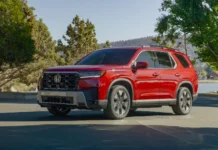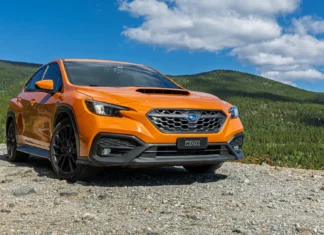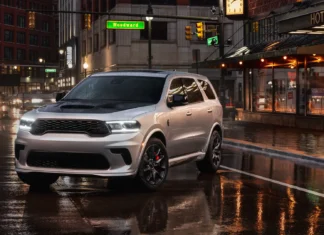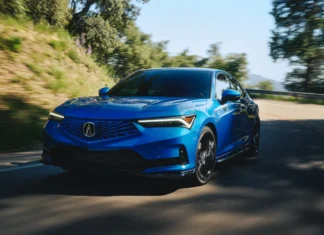| Pros | Cons |
| ✓ Quirky styling inside and out | ☓ Pricey; no cheaper single-motor option |
| ✓ Stupidly quick | ☓ Some tech/software issues |
| ✓ Solid initial build quality | ☓ Tight back seat space |
| ✓ Decent range for its size |
The 2025 Volvo EX30 is a ton of fun, but is it a no-brainer for your next (or first) EV?
I’ve been waiting to drive the Volvo EX30 for a long time. Part of that comes down to the car’s delay actually reaching U.S. buyers. The EX30 was supposed to reach our shores last year, but Volvo delayed it due to a mix of heavy 100% tariffs on Chinese-built EVs (which torpedoed Volvo’s original production plan) and software issues throughout 2024, one of which necessitated a recall of more than 71,000 vehicles. But here we are in 2025: Volvo shifted production for North American EX30s to Ghent, Belgium and rolled out a few software updates to iron out the initial bugs. You can finally buy or lease a new Volvo EX30 from your local dealer, but should you?
I actually rolled into our week-long test with a good friend in mind, and whether it’d make sense for them. If you need a small, distinctive and premium-feeling electric SUV to make your new daily driver, this seems to check all the boxes — at least on paper. On that first bit, the 2025 Volvo EX30 has some nice and tidy, city-friendly dimensions. For a $46,195 starting price, you get an SUV that measures out to 166.7 inches long (in other words, nearly two feet shorter than the compact XC60), 72.4 inches wide and 61.2 inches tall. You’re not going to struggle traversing narrow city streets or trying to park, and the car will help you out on the parking front when you need it.
That is, if you’re willing to absorb that initial price tag. Volvo initially made waves saying the EX30 will be its “affordable” EV meant to bring young drivers into the fold. To that end, we were supposed to get a cheaper single-motor model. Then global events shook the market, to the point where Tesla cancelled its cheaper EV (though it’s since announced a “cheap” Model Y) and Volvo did the same. We might see the more affordable version return at some point, but that’s currently up in the air.
If you’re looking to buy a 2025 Volvo EX30, then, your only option is the Twin Motor Performance model with standard all-wheel drive. That ought to help your all-weather needs, and it just happens to have 422 horsepower on tap. That means this pipsqueak EV can sprint from 0-60 in 3.4 seconds…all the more fun to blow off that 702-horsepower Ram TRX in the dust at the lights.
Even with that sort of power, the EX30’s 64-kWh battery pack manages an EPA-estimated 253 miles on a charge. At first glance, at least, that’s not terrible for a small SUV (with some caveats), and we have a Loveland Trials up on our TFLEV channel to see how it performs under some extreme elevation changes. It’s not quite what we expected.
On the whole, the 2025 Volvo EX30 proved itself to be the least grown-up Volvo I’ve driven in awhile, and in a lot of ways that’s a great thing. It looks fun inside and out and it feels fun to drive, which are both plus points for the young people Volvo’s targeting here, and it even uses recycled materials throughout the interior, to boot. There’s a lot to like, but it’s not perfect — and I’ll go into details for each side of that equation below.
This tiny crossover offers huge performance…for a price
If there’s one word you needed to describe Volvo’s approach to performance with its existing plug-in hybrids, it’s “sleeper”. That philosophy translates to its battery-electric cars as well, because the new EX30 is a pocket rocket. And sure, the specs obviously suggest it’s quick, but the experience is another matter.
Going into our testing, I was worried Volvo would take the Tesla approach of front-loading that performance so any full-bore start would basically snap your neck. That at least sums up most of my time driving or riding shotgun in the Model Y Performance, and it is fun to do…at first. Fortunately, this EX30 gives you a more linear (and enjoyable) surge. For its 4,190-pound curb weight, Volvo’s tiny EV shrugs off the heft the first time you stab the throttle, and that’s while riding on range-boosting all-season tires.
Even through the corners, the 2025 Volvo EX30 holds on well, though the weight and tire setup keeps it short of feeling like a sports car. For the most part, I just hung on to the squircle steering wheel and gunned it — with little protest in the way of tire squeal, even with the traction control off. The whole “it’s a Volvo” thing does come back into the equation the faster you go, however, as the top speed is limited to 112 mph.
The EX30 has plenty of satisfying oomph, then, but there are a few downsides. I found the suspension feels little crashy over bumps (that said, Colorado’s roads suck, to put things generously), and the steering — in typical EV fashion — is largely devoid of meaningful feel or feedback. In fact, Volvo does offer up three settings to adjust the steering weight, and I’d strongly recommend sticking with the “Firm” setting. Putting it on “Soft” may sound nice for your daily commute, and it may be all right at slow speeds, but keeping it there in highway driving results in twitchy front end with any sudden movements.
Range and charging speed are things you’ll want to think about before buying an EX30
Here’s the rub with taking your tiny EV (with a consequently small battery) and giving it lots of power: lower driving range. On paper, I’d consider the EX30’s 64-kWh battery and advertised 253-mile range to be decent given its size. At about 3 miles per kilowatt-hour, my time driving the EX30 was okay. I didn’t have any severe range issues, and was actually able to keep that smaller pack replenished for my daily commute off a standard 110-volt outlet.
That said, if you do start hammering it around or taking it out onto the big, bad highways for a road trip, that range will drop off considerably. That’s because the CCS charging port — there’s no Tesla-style NACS port on the 2025 models — caps out at 153 kW while DC fast-charging. That’s pretty pokey by modern standards, and you’re looking at the best-case scenario to even hit that rate. Volvo claims a 10-80% charging time of just under 30 minutes, but considering that amount of charge is only enough to take you about 150 miles…you’ll probably want to consider another option at the EX30’s price point if you’re looking to drive long-distance. Getting the best results out of Volvo’s entry-level EV really depends on your use case.
Then there’s the software…
I commend the 2025 Volvo EX30 Twin Motor Performance for being, at the risk of sounding like a complete dork, electric to drive. When you finally do take the plunge into EV living, though, long-term satisfaction comes from owning a trouble-free car, especially when it comes to its software. And that’s an area where, at least in my experience, the EX30 falls down.
First off, let’s cover the upper portion of the EX30’s 12.3-inch center touchscreen. This is where Volvo places all your crucial driving information, and boy does it ever feel familiar. From some of the text to the layout and even the small vertical power/regen gauge, the Tesla vibes are stronger than ever here than with other Volvo and Polestar EVs. Some of you guys may not mind that, but it’d be nice to see some more originality on a similar level to the funky exterior styling or using more eco-conscious interior materials.
Granted, I managed to get past that gripe after the first couple days with the EX30. That’s because the car’s software threw other, more frustrating issues my way. For example, Apple CarPlay would continuously refuse to connect when I stepped into the vehicle, even when my phone would connect through Bluetooth.
According to the sliders in the vehicle settings, too, selecting “Performance All-Wheel Drive” is supposed to disable one-pedal drive. Physically, it does, but the actual one-pedal drive settings remain enabled, suggesting that it’s still active both on the vehicle settings menu and in the “Quick controls” menu. Then there are the lane-keep assist and the infuriatingly pervasive driver monitoring system that will bong at you if your eyes aren’t dead center on the road at all times. Yes, you can turn them off, but they always come back when you power-cycle the car.
Like so many other EVs these days, the 2025 Volvo EX30 also hides its headlight settings in the infotainment system. Again, you have to go to a menu, then another menu in the vehicle settings…but unlike, say, General Motors, you then have to press “OK” on the steering wheel to actually turn the headlights on. Why?
Long and short of it: As fun as it is to drive, the EX30’s software still feels half-baked, even with the company’s efforts to improve it after the initial launch.
The Volvo EX30’s interior looks great and feels premium where it matters.
Much the same as I seriously like Volvo’s exterior design with this car, the interior team also did a great job with the overall aesthetic. You still get that minimalist flavor (even if you do lose some useful switchgear to the infotainment screen), while every piece you regularly touch feels high-quality. Even the door handles are remarkably well integrated, and at least Volvo resisted using stupid electronic door poppers like so many other EVs.
The small EX30 does struggle for storage space, but you do get a drop-down glovebox that drops down from the center of the dash, a wireless smartphone charger, a storage cubby with two USB-C ports and more pop-out storage from the center console. There’s also a useful top plate that allows that sliding area to be used as general purpose storage or as two cupholders. Under the hood, the EX30 does have a small frunk with a fun Swedish Easter egg, which is better than nothing at all.
Despite some clever touches, there are areas the Volvo EX30 doesn’t feel quite so premium. The design of the center console is indeed useful, but if you’re not a fan of that sort of cheap-feeling, rubberized plastic, then you’ll have a constant reminder of cost-cutting right there. The door cards are also mostly hard plastic and only have a couple modestly sized storage compartments. No speakers in the front doors, no door controls, and nothing to really make those materials feel like this is the nearly $50,000 car it is. You’ll also get a small reminder with the window switches. You only get two in the center, with a touch-sensitive button to switch between controlling the front windows or the rear windows.
On the audio front, Volvo substituted conventional door speakers and tweeters for a single Harman Kardon soundbar mounted atop the dash. It does the job, but you don’t get an audiophile’s best experience as you might expect for a vehicle at this price point (even an EV at this price point).
Being such a small car, the 2025 Volvo EX30 also involves compromises on both the rear seat space and the cargo area. While the front row brings a fairly generous 41.9 inches of legroom, there’s only up to 32.3 inches of legroom for the second-row passengers. That could make things tricky when you’re dealing with seating adults or using a rear-facing car seat.
A similar story plays out with cargo space. With the second row in place, the EX30 offers up 12.4 cubic feet of cargo space — about the same as your typical compact sedan’s trunk. Fold the rear seats down, and that volume expands out to 27.8 cubic feet. Helpfully, Volvo does include a “will it fit?” diagram on the interior tailgate panel listing the car’s cargo dimensions.
Verdict: A seriously fun little EV, but also a pricey one.
It’s been a bit of a rocky road for Volvo’s newest, smallest EV, and this is what we’ve ended up with. The 2025 Volvo EX30 Twin Motor Performance brings hot rod-like performance to the table, but we don’t get a more affordable single-motor version (at least not yet).
Instead, if you want this particular EV, you’ll have to shell out at least $46,195 for the Plus trim. If you want the Ultra like we tested here, which adds in Volvo’s Pilot Assist, a 360-degree camera and Park Pilot Assist among a few other features, you’ll have to spend $47,895. If you live in a cold climate and want heated seats and a heated steering wheel, the $500 Climate Package is a necessity, but pushes the bottom-line price even closer to $50K (and over the line, depending on your tax situation).
Is the 2025 Volvo EX30 worth it for my good friend, and is it worth your money? Against other premium offerings like the Mini Countryman SE, I’d definitely lean toward Volvo’s offering for being quirky and generally more fun. That size also makes handling this little runabout easy as can be. If you’re looking for something a little more rugged, albeit more expensive, there’s also a Cross Country version of the EX30 on the way.
On the other hand, other mainstream EVs like the Hyundai Ioniq 5, Kia EV6, Ford Mustang Mach-E, Chevrolet Equinox EV and (naturally) the Tesla Model Y offer a far better size, range and value advantage, if you’re willing to give up a bit of performance. That balance might shift once Volvo finally something closer to the $35K “Core” model it pitched at the beginning of the EX30 saga, but until that happens, the high price tag shrinks the pool of potential buyers.






















